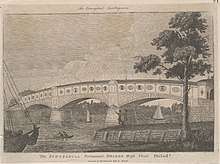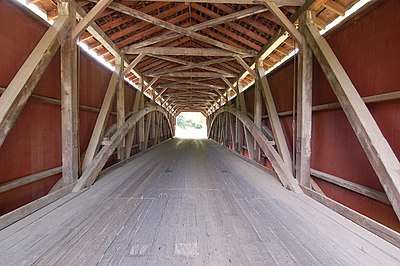Covered bridge
A covered bridge is a timber-truss bridge with a roof, decking, and siding, which in most covered bridges create an almost complete enclosure.[1] The purpose of the covering is to protect the wooden structural members from the weather. Uncovered wooden bridges typically have a lifespan of only 20 years because of the effects of rain and sun, but a covered bridge could last 100 years.[2]
The Cogan House Covered Bridge, Pennsylvania | |
| Ancestor | Truss bridge, others |
|---|---|
| Descendant | None |
| Carries | Pedestrians, livestock, vehicles |
| Span range | Short |
| Material | Typically wood beams with iron fittings and iron rods in tension |
| Movable | No |
| Design effort | Low |
| Falsework required | Determined by enclosed bridge structure, site conditions, and degree of prefabrication |
Design
Typically, covered bridges are structures with longitudinal timber-trusses which form the bridge's backbone. Some were built as railway bridges, using very heavy timbers and doubled up lattice work.[3]
Most bridges were built to cross streams, and the majority had just a single span. Virtually all contained a single lane. A few two-lane bridges were built, having a third, central truss.[3]
Many different truss designs were used. One of the most popular designs was the Burr Truss, patented in 1817, which used an arch to bear the load, while the trusses kept the bridge rigid. Other designs included the King, Queen, Lattice, and Howe trusses.
Early trusses were designed without an understanding of the engineering dynamics at work.[4] In 1847, American engineer Squire Whipple published the first correct analysis of the way a load is carried through the truss,[5] which enabled him to design stronger bridges with fewer materials.
Bridges
.jpg)
About 1,600 covered bridges remain in the world.[6] The relatively small number of surviving bridges is due to deliberate replacement, neglect, and the high cost of restoration.[7] They tend to be in isolated places, making them subject to vandalism and arson.[8]
Europe
The oldest surviving truss bridge in the world is the Kapellbrücke in Switzerland. Modern-style timber truss bridges were pioneered in Switzerland in the mid-1700s.[4]
United States

About 14,000 covered bridges have been built in the United States,[9] mostly in the years 1825 to 1875.[2] Today, surviving bridges are numbered at fewer than 1,000 by the United States Department of Transportation,[10] and at 814 by The National Society for the Preservation of Covered Bridges as of 2009.[11]
The first known covered bridge constructed in the United States was the Permanent Bridge, completed in 1805 to span the Schuylkill River in Philadelphia.[12][13] However, most other early examples of covered bridges don't appear until the 1820s. Extant bridges from that decade include New York's Hyde Hall Bridge and Pennsylvania's Hassenplug Bridge, both built in 1825, and the Haverhill-Bath Covered Bridge and the Roberts Covered Bridge, in New Hampshire and Ohio respectively, both built in 1829.[3] The longest, historical covered bridges remaining in the United States are the Cornish-Windsor Bridge, spanning the Connecticut River between New Hampshire and Vermont, and Medora Bridge, spanning the East Fork of the White River in Indiana. Both lay some claim to the superlative depending upon how the length is measured.[14]
In the mid-1800s, the development of cheaper wrought iron and cast iron led to metal rather than timber trusses.[3] Metal structures did not need protection from the elements, so no longer needed to be covered. The bridges also became obsolete because most were single-lane, had low width and height clearances, and could not support the heavy loads of modern traffic.[3]
Canada
Between 1969 and 2015, the number of surviving covered bridges in Canada declined from about 400 to under 200.[15]
In 1900, Quebec had an estimated 1,000 covered bridges.[16] Relative to the rest of North America, Quebec was late in building covered bridges, with the busiest decade for construction being the 1930s.[17] Initially, the designs were varied, but around 1905, the design was standardised to the Town québécois, a variant on the lattice truss patented by Ithiel Town in 1820. About 500 of these were built in the first half of the 1900s.[17] The last bridge was built by the Ministry of Colonisation in 1958 in Lebel-sur-Quévillon.[17] There are now 82 covered bridges in Quebec, Transports Québec including the Félix-Gabriel-Marchand Bridge, the province's longest covered bridge.[18]
In 1900, New Brunswick had about 400 covered bridges. Today, there are 58 covered bridges in New Brunswick, including the world's longest, the Hartland Bridge.[19]
In fiction
In addition to being practical, covered bridges were popular venues for a variety of social activities[2] and are an enduring cultural icon;[20] for example:
- The 1992 novel, The Bridges of Madison County, featured the Cedar Covered Bridge, which has since been burnt by arson in 2002, replaced with a replica, and burnt by arson again in 2017.
- The Edgar Allan Poe story "Never Bet the Devil Your Head"
- Plot points in the 1988 comedy films Beetlejuice and Funny Farm refer to them.
- The Diehls Covered Bridge in Pennsylvania is featured in the opening scenes of the 1980s anthology horror television series Tales from the Darkside, created by George A. Romero.
- The Joe Hill novel "NOS4A2" Features a character named Victoria McQueen that utilizes a covered bridge called the "Shorter Way" as a portal to travel instantly across vast distances.
Gallery
 Baumgardener's Covered Bridge, showing the truss protected by the covering
Baumgardener's Covered Bridge, showing the truss protected by the covering- The 1,282-foot (391 m) Hartland Bridge in New Brunswick is the longest covered bridge in the world.
See also
- Architectural structure
- List of nonbuilding structure types
References
- "Covered bridge". Encyclopædia Britannica. Retrieved 8 October 2012.
- "Ohio's Vanishing Covered Bridges". Federal Highway Administration. Retrieved 8 January 2019.
- "Covered Bridge Manual". Federal Highway Administration. Retrieved 9 October 2012.
- "Bridge - Timber truss bridges". Encyclopedia Britannica. Retrieved 9 January 2019.
- Allen, Richard Sanders (2004). Covered Bridges of the Northeast. Courier Corporation. p. 84. ISBN 978-0-486-43662-3.
- "World Guide to Covered Bridges". National Center for Wood Transportation Structures. Retrieved 8 January 2019.
- Ross, Robert J.; et al. (August 2012). "Use of Laser Scanning Technology to Obtain As-Built Records of Historic Covered Bridges" (PDF). U.S. Department of Agriculture. Research Paper FPL-RP-669. Retrieved 9 January 2019. Cite journal requires
|journal=(help) - Phares, Brent; et al. (May 2013). "Covered Bridge Security Manual" (PDF). U.S. Department of Agriculture. General Technical Report FPL-GTR-223. Cite journal requires
|journal=(help) - Covered Bridge Manual (PUBLICATION NO. FHWA-HRT-04-098) (PDF). McLean, VA: U. S. Department of Transportation Federal Highway Administration. April 2005. p. 3. Retrieved 27 February 2020.
- Anthony, Ronald W. (January 2018). "Guidelines to Restoring Structural Integrity of Covered Bridge Members" (PDF). U.S. Department of Agriculture. Genertal Technical Report FPL-GTR-252. Cite journal requires
|journal=(help) - World Guide to Covered Bridges. The National Society for the Preservation of Covered Bridges, Inc. 2009. p. lxii.
- Griggs, Frank Jr. (October 2013). "The Permanent Bridge". Structure Magazine. Retrieved 9 January 2019.
- Christianson, Justine, et al. Covered Bridges and the Birth of American Engineering. Washington, D.C.: National Park Service, Historic American Engineering Record, 2015.
- "Covered Bridge Trivia". www.coveredbridgesociety.org. National Society for the Preservation of Covered Bridges. Retrieved 27 February 2020.
- Walker, Nick (28 May 2015). "Throwback Thursday: Covered bridges". Canadian Geographic. Retrieved 8 January 2019.
- "Ponts couverts" (in French). Transports Quebec. Archived from the original on 24 February 2012.
- Lefrançois, Jean (2004). "Les ponts couverts au Québec, héritage précieux" (PDF) (in French). Ministère des Transports du Québec. Retrieved 8 January 2019. Cite journal requires
|journal=(help) - "Programmation routière 2018-2020 - Plus de 157 M$ pour améliorer la sécurité et la qualité de vie des usagers de la route en Outaouais" (in French). Transports Québec. 5 March 2018. Retrieved 8 January 2019.
- "Covered Bridges". Government of New Brunswick. Retrieved 11 July 2019.
- "Covered Bridges". The Warren E. Roberts Museum of Early Indiana Life. Indiana University Bloomington. 2007. Retrieved 8 January 2019.
External links
| Wikimedia Commons has media related to Covered bridges. |
- Covered Bridge Map, an interactive map showing locations of covered bridges in the United States and Canada
